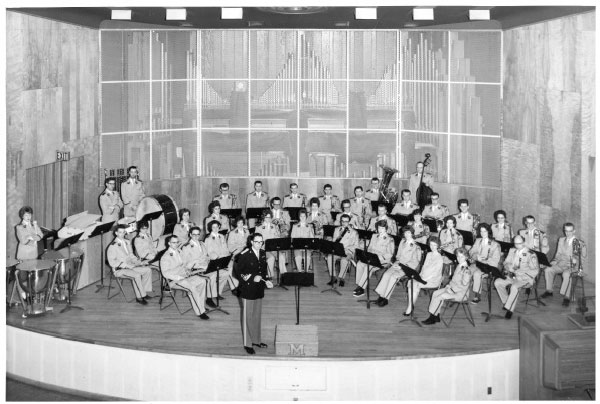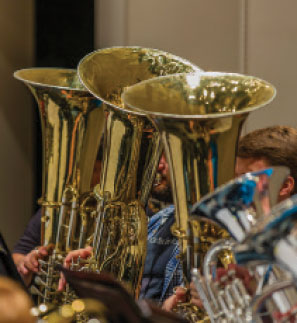

The Magazine of The University of Montana
ARTIFACTS:
The Tale of UM’s Tubas
By John Heaney ’02

The University of Montana Chamber Band, 1962-63.
Photo courtesy of Mansfield Library Archives and Special Collections

The tuba played in that band is still in use today.
Photo by Ken Stolz
“The tuba is critical,” says Smart, director of bands and trumpet in UM’s School of Music. “All the sounds of the group are built on top of the bass instrument sounds. And without a good bass sound, without good intonation there, then it’s pretty much impossible to stack the sounds on top of it. Without it, it’s like turning off the bass on your speakers at home.”
For UM’s Concert Band and Symphonic Wind Ensemble, the foundation that their tubas provide is crumbling.
The four German-made Miraphone tubas the students use today were purchased between 1958 and 1965, making them by far the school’s oldest instruments still in use. While they were excellent tubas at the time of purchase, more than fifty years of use have taken their toll.
The tuba is the largest brass instrument, with the uncoiled tube measuring nearly nineteen feet. They weigh around thirty pounds and consist of many moving, metal parts.
“Unlike a Stradivarius violin, for example, tubas don’t appreciate with age,” Smart says. “So string instruments get better, but woodwind and brass instruments, generally, degrade and get worse.”
Scores of students have played UM’s tubas over the years in thousands of performances. And the hours of practice time logged on these instruments?
“Well, I hope that number is countless,” Smart says with a laugh.
UM’s tubas have a remarkable history. In fact, if you look back far enough, it’s noted that George Washington played one of these instruments.
George Washington of Milwaukee, Wisc., that is. He was a UM student in the early 1960s.
There’s more:
• In 1964, a jazz trumpet phenom billed as Carl Severinson visited campus and played with UM’s Concert Band, which included these tubas. Severinson, better known as “Doc,” went on to lead the NBC Orchestra on The Tonight Show with Johnny Carson.
• A few years later, UM tubists Dennis Hale, John Stratman, and Kenneth Leslie lugged the tubas to Ann Arbor, Mich., for a concert at Hill Auditorium, a famous venue at the University of Michigan. The concert was part of the College Band Directors National Association Conference.
• In 1969, Hale played tuba in a brass sextet with Missoula high schooler Allen Vizzutti. Vizzutti, a trumpeter, later became a celebrated recording artist.
• In 1979, UM student Patrick Quinn played one of these tubas in the Missoula Symphony Orchestra’s performance of Johann Sebastian Bach’s St John Passion under the baton of world-renowned conductor Robert Shaw.
UM’s tubas have served the School of Music well. But now it’s time for new ones.
Ben Kirby, adjunct professor of tuba and euphonium at UM, says it’s a challenge to teach students on instruments in this condition.
“I have to be careful what I say to students,” says Kirby, who plays tuba in symphonies in Missoula, Great Falls, and Billings. “I don’t want to deny their ability to try, yet these instruments present roadblocks to what is now known as normal tuba playing.”
Tubas are expensive instruments, creating the need for the school to raise funds for four new tubas, which would cost in the neighborhood of $35,000.
In addition to traditional fundraising avenues, Kirby offers a creative way to earn donations. He, along with three UM students, form a tuba and euphonium quartet that plays concert-ready music at parties or events in exchange for a contribution to a fund specifically for new tubas.
“The tubas we have now have been played under great conductors, played by great people, and traveled all over the country,” Smart says. “They’ve been great. But now they are destined for that hallowed instrument boneyard in the sky.”
For more information about UM’s tuba fund, call UM School of Music Business Manager Rayleen Hicks at 406-243-6881 or email rayleen.hicks@mso.umt.edu.

 Email Article
Email Article 